
Tipu Sultan, commonly referred to as Sher-e-Mysore or "Tiger of Mysore", was the Indian Muslim ruler of the Kingdom of Mysore based in South India. He was a pioneer of rocket artillery. He introduced a number of administrative innovations during his rule, including a new coinage system and calendar, and a new land revenue system, which initiated the growth of the Mysore silk industry. Tipu was also a pioneer in introducing Channapatna toys. He expanded the iron-cased Mysorean rockets and commissioned the military manual Fathul Mujahidin. He deployed the rockets against advances of British forces and their allies during the Anglo-Mysore Wars, including the Battle of Pollilur and Siege of Srirangapatna.
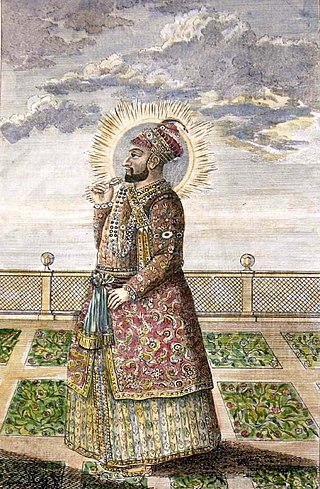
Hyder Ali was the Sultan and de facto ruler of the Kingdom of Mysore in southern India. Born as Hyder Ali, he distinguished himself as a soldier, eventually drawing the attention of Mysore's rulers. Rising to the post of Dalavayi (commander-in-chief) to Krishnaraja Wodeyar II, he came to dominate the titular monarch and the Mysore government. He became the de facto ruler of Mysore as Sarvadhikari by 1761. During intermittent conflicts against the East India Company during the First and Second Anglo–Mysore Wars, Hyder Ali was the military leader.
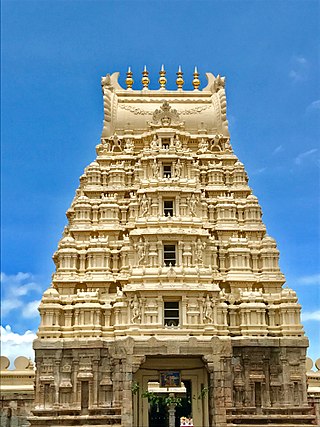
Srirangapatna is a town and headquarters of one of the seven Taluks of Mandya district, in the Indian State of Karnataka. It gets its name from the Ranganthaswamy temple consecrated around 984 CE. Later, under the British rule, the city was renamed to Seringapatnam. Located near the city of Mandya, it is of religious, cultural and historic importance.

The Kingdom of Mysore was a realm in southern part of Deccan Plateau traditionally believed to have been founded in 1399 by two Hindu brothers, in the vicinity of the modern city of Mysore. From 1799 until 1950, it was a princely state, until 1947 in a subsidiary alliance with British India. The British took direct control over the princely state in 1831. Upon accession to the Dominion of India, it became Mysore State, later uniting with other Kannada speaking regions to form the state of Karnataka, with its ruler remaining as Rajapramukh until 1956, when he became the first governor of the reformed state.

The First Anglo-Mysore War (1767–1769) was a conflict in India between the Sultanate of Mysore and the East India Company. The war was instigated in part by the machinations of Asaf Jah II, the Nizam of Hyderabad, who sought to divert the company's resources from attempts to gain control over the Northern Circars.

The Anglo-Mysore Wars were a series of four wars fought during the last three decades of the 18th century between the Sultanate of Mysore on the one hand, and the British East India Company, Maratha Empire, Kingdom of Travancore, and the Kingdom of Hyderabad on the other. Hyder Ali and his succeeding son Tipu fought the wars on four fronts: with the British attacking from the west, south and east and the Nizam's forces attacking from the north. The fourth war resulted in the overthrow of the house of Hyder Ali and Tipu, and the dismantlement of Mysore to the benefit of the East India Company, which took control of much of the Indian subcontinent.
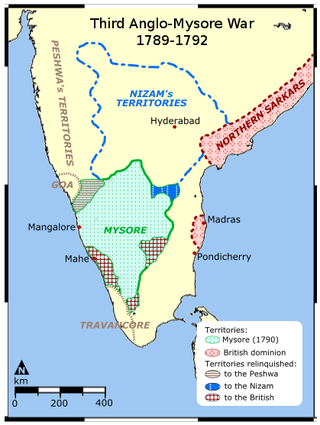
The Third Anglo-Mysore War (1790–1792) was a conflict in South India between the Kingdom of Mysore and the British East India Company, the Kingdom of Travancore, the Maratha Empire, and the Nizam of Hyderabad. It was the third of four Anglo-Mysore Wars.

The Fourth Anglo-Mysore War was a conflict in South India between the Kingdom of Mysore against the British East India Company and the Hyderabad Deccan in 1798–99.

Madhavrao II was the 12th Peshwa of the Maratha Empire in India, from his infancy. He was known as Sawai Madhav Rao or Madhav Rao Narayan. He was the posthumous son of Narayanrao Peshwa, murdered in 1773 on the orders of Raghunathrao. Madhavrao II was considered the legal heir, and was installed as Peshwa by the Treaty of Salbai in 1782 after First Anglo-Maratha War.

Bangalore Fort began in 1537 as a mud fort. The builder was Kempe Gowda I, a vassal of the Vijaynagar Empire and the founder of Bangalore. Hyder Ali in 1761 replaced the mud fort with a stone fort and it was further improved by his son Tipu Sultan in the late 18th century. It was damaged during an Anglo-Mysore war in 1791. It still remains a good example of 18th-century military fortification. The army of the British East India Company, led by Lord Cornwallis on 21 March 1791 captured the fort in the siege of Bangalore during the Third Mysore War (1790–1792). At the time the fort was a stronghold for Tipu Sultan. Today, the fort's Delhi gate, on Krishnarajendra Road, and two bastions are the primary remains of the fort. A marble plaque commemorates the spot where the British breached fort's wall, leading to its capture. The old fort area also includes Tipu Sultan's Summer Palace, and his armoury. The fort has provided the setting for the treasure hunt in the book Riddle of the Seventh Stone.
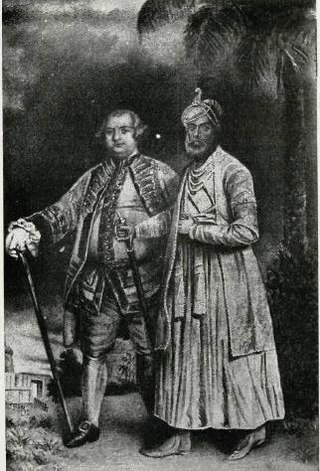
Madras Presidency was an administrative subdivision (presidency) of British India. At its greatest extent, Madras Presidency included much of southern India, including the present-day Indian State of Tamil Nadu, the Malabar region of North Kerala, Lakshadweep Islands, the Coastal Andhra and Rayalaseema regions of Andhra Pradesh, Brahmapur and Ganjam districts of Orissa and the Bellary, Dakshina Kannada, and Udupi districts of Karnataka. The presidency had its capital at Madras.
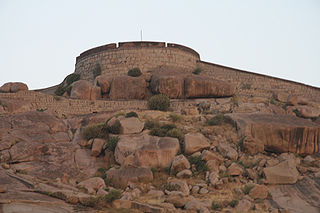
The Bellary Fort was built on top of a hill called the "Ballari Gudda" or the Fort Hill. It is situated in the historic city of Bellary, in the Bellary district, in Karnataka state, India. It was built in two parts namely, the Upper Fort and the Lower Fort. The Upper Fort was built by Hanumappa Nayaka, a feudatory of Vijayanagara Empire, but the Lower Fort was built by Hyder Ali in later part of the 18th century.

Dhondia Wagh was a military soldier and adventurer in 18th century India. He started his career in the service of Hyder Ali, the ruler of Mysore. During the Third Anglo-Mysore War, he deserted Ali's successor Tipu Sultan, and subsequently raided territories on the Maratha-Mysore border. After the Marathas forced him to retreat, he sought refuge from Tipu and converted to Islam, changing his name to Malik Jahan Khan. After Tipu's death in the Fourth Anglo-Mysore War, he raised a force comprising soldiers from the former Mysore Army, and took control of northern part of the Mysore Kingdom. He styled himself as Ubhaya-Lokadheeshwara. The British East India Company as well as the Maratha Peshwa sent armies to check his rising power. He was ultimately defeated and killed by a British force led by Arthur Wellesley.
The Treaty of Seringapatam, signed 18 March 1792, ended the Third Anglo-Mysore War. Its signatories included Lord Cornwallis on behalf of the British East India Company, representatives of the Nizam of Hyderabad and the Maratha Empire, and Tipu Sultan, the ruler of Mysore.

The 1792 siege of Seringapatam was a battle and siege of the Mysorean capital city of Seringapatam (Srirangapatna) at the end of the Third Anglo-Mysore War. An army led by Charles, Earl Cornwallis, consisting of British East India Company and British Army forces, along with allied forces from the Maratha Empire and the Nizam of Hyderabad, arrived at Seringapatam on 5 February 1792, and after less than three weeks of battle and siege, forced Tipu Sultan to capitulate. With his agreement to the Treaty of Seringapatam on 18 March 1792, the war came to an end.

British General Charles Cornwallis, the Earl Cornwallis, was appointed in February 1786 to serve as both Commander-in-Chief of British India and Governor of the Presidency of Fort William, also known as the Bengal Presidency. He oversaw the consolidation of British control over much of peninsular India, setting the stage for the British Raj. He was also instrumental in enacting administrative and legal reforms that fundamentally altered civil administration and land management practices there. According to historian Jerry Dupont, Cornwallis was responsible for "laying the foundation for British rule throughout India and setting standards for the services, courts, and revenue collection that remained remarkably unaltered almost to the end of the British era."
The Maratha–Mysore Wars were a conflict in 18th century India between the Maratha Empire and the Kingdom of Mysore. Though initial hostilities between the sides started in 1770s, the last battle began on February 1785 and ended in 1787.

The Mysorean invasion of Malabar (1766–1792) was the military invasion of the Malabar region of Kerala, including the territories of the Zamorin of Calicut, by the then-de facto ruler of the Kingdom of Mysore, Hyder Ali. After the invasion, the Kingdom of Cochin to the south of Malabar became a tributary state of Mysore.
Mysorean rockets were an Indian military weapon, the iron-cased rockets were successfully deployed for military use. The Mysorean army, under Hyder Ali and his son Tipu Sultan, used the rockets effectively against the British East India Company during the 1780s and 1790s. Their conflicts with the company exposed the British to this technology further, which was then used to advance European rocketry with the development of the Congreve rocket in 1805.
Ballari pronounced is a historic city in Bellary district in Karnataka state, India.















